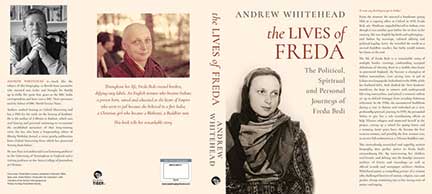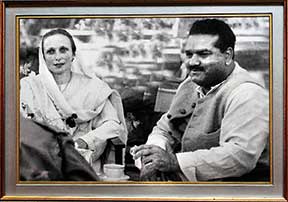Chintan Girish Modi
I am fascinated by people who defy conventional understandings of reality wrapped into little boxes with no room for individual agency. They destabilize our assumptions around what is possible, and push us to see how prejudice clouds our view.
 Freda Bedi is the person whose story has done this to me most recently. Her new biography titled The Lives of Freda: The Political, Spiritual and Personal Journeys of Freda Bedi would be of interest to those who study and teach the Indian freedom struggle but are a bit exhausted with the centrality of men in that narrative and would like to learn more about women who participated in efforts to decolonize India from British rule. It was written by Andrew Whitehead, and published earlier this year by Speaking Tiger.
Freda Bedi is the person whose story has done this to me most recently. Her new biography titled The Lives of Freda: The Political, Spiritual and Personal Journeys of Freda Bedi would be of interest to those who study and teach the Indian freedom struggle but are a bit exhausted with the centrality of men in that narrative and would like to learn more about women who participated in efforts to decolonize India from British rule. It was written by Andrew Whitehead, and published earlier this year by Speaking Tiger.
“She lived for two-thirds of her life in India, adopted its national cause and customs, and took an Indian passport,” writes Whitehead. “She served a prison sentence in Lahore as part of Gandhi’s protests against an imperial power which happened to be her motherland. She was an English champion of Indian nationalism. Freda Bedi delighted in confounding accepted definitions of identity. She could not easily be categorized and saw no reason why she should be.”
She was born and raised in England, and was known as Freda Houlston up until she got married to Pyare Lal Bedi, a man she fell deeply in love with while studying at Oxford. The physical attraction and emotional intimacy were matched by intellectual comradeship, which was founded on a shared love of communist ideas. Working to improve the situation of people suffering from poverty, displacement, social inequality and disease was a lifelong commitment for her but she parted ways with communism much before her husband did.
They moved to India in 1934, just a year after the marriage, and a significant period of their life was spent in Lahore. In those days, that city, which is now in Pakistan, was part of India. Whitehead’s book offers a delicious account of the life they built together, heady with the desire to change things, living with fewer material comforts despite the privileges they could choose to access, and surrounding themselves with artists and intellectuals. They were a power couple that addressed public meetings, wrote and published together, and earned the respect of the locals as they created trouble for the British Raj.
“Freda Bedi’s wartime incarceration in Lahore Female Jail is the act of valour which forged her reputation as a nationalist icon,” remarks Whitehead, a British journalist who is married to an Indian woman, and has spent several years in India. “Thousands of Indian nationalists and leftists were detained for opposing India’s participation in the Second World War. Vanishingly few of these were English and white skinned and so identified in the public mind with the coloniser rather than the colonised. Freda was, of course, both undeniably English and unequivocally on India’s side.”
I wonder how she would have engaged with contemporary debates around identity politics and cultural appropriation. That can only be a matter of conjecture since she does not live among us today. She insisted on being called Indian, wore a sari, showed tremendous fortitude while adapting to the challenges of living in a patriarchal family, and also took on the task of learning Punjabi. When she was jailed “under an initiative launched and overseen by Mahatma Gandhi, who personally approved all those who were to be his satyagrahis,” she was also a young mother who had to bear the pain of leaving her son Ranga in the care of his grandmother. Pyare Lal was already in another prison by this time.
“She was the first, and perhaps the only, European woman to be part of this phase of Gandhi’s non-violent protest against the Imperial power,” writes Whitehead. Sentenced to six months of imprisonment, she used her time there to develop friendships with other political prisoners, and to educate herself about the lives of fellow inmates who were jailed for “the desperate acts they had been pushed to by a profoundly unequal and patriarchal society.” These acts included killing abusive husbands, and eloping with lovers.
After her release, Freda began writing a newspaper column that provided detailed accounts of her time behind bars. She used to wake up early, meditate under trees in the jail compound, and work in the prison gardens. There was a lot of socializing as well. Whitehead writes, “Freda of course regarded herself as Indian but her act of protest gained attention and achieved impact precisely because she was not Indian…However much she might seek to forsake the special status accorded in colonial India to those with white skins, it was an indelible aspect of her life there.”
 Freda was close to Jawaharlal Nehru, the first Prime Minister of India, and built on this connection to be part of several important projects that gave her an opportunity to serve the Indian people. It might be tempting to think of her as an entitled White woman with a saviour complex but I think that description is uncalled for. She was the principal breadwinner in the family because her husband was not able to keep a stable job, and he had a tendency to splurge as soon as he earned something. Her work included travelling to remote villages, and reporting on conditions there to ensure that they got the support they needed. He was impressed by Freda’s sincerity, and her ability to get things done. She was given the responsibility of playing a key role in the rehabilitation of Tibetan refugees who escaped the Chinese and fled to India in and after 1959.
Freda was close to Jawaharlal Nehru, the first Prime Minister of India, and built on this connection to be part of several important projects that gave her an opportunity to serve the Indian people. It might be tempting to think of her as an entitled White woman with a saviour complex but I think that description is uncalled for. She was the principal breadwinner in the family because her husband was not able to keep a stable job, and he had a tendency to splurge as soon as he earned something. Her work included travelling to remote villages, and reporting on conditions there to ensure that they got the support they needed. He was impressed by Freda’s sincerity, and her ability to get things done. She was given the responsibility of playing a key role in the rehabilitation of Tibetan refugees who escaped the Chinese and fled to India in and after 1959.
This was a defining moment in Freda’s life. She became profoundly involved with the Tibetans, and with Buddhist teachings, as she was in charge of running a school for lamas who had been handpicked from the Misamari refugee camp in Assam to learn English. She became a nun, and her teacher was the 16th Karmapa of the Kagyu School of Tibetan Buddhism. Thereafter, she was known as Sister Palmo.
Whitehead has managed to offer a comprehensive picture of Freda’s rich and illustrious life, including inputs from people who were not particularly fond of her. His research is quite solid. Reading his book made me wish I had met Freda in person. England’s loss was India’s gain, one might say, but the irony was that her own friend, Prime Minister Indira Gandhi, selected her to be one of 46 ‘foreign women’ who were awarded for their outstanding services to India. As someone who saw herself as Indian, she was upset but had to get over it. She was one among many who were not born on Indian soil but devoted themselves to India. Her story is worth celebrating at a time when we are becoming increasingly obsessed with narrow definitions of what it means to be Indian.
The author is a writer, educator and researcher. He has an M.Phil. in English Language Education, and several years of experience as a workshop facilitator with students and teachers. He can be reached at chintan.prajnya@gmail.com.
